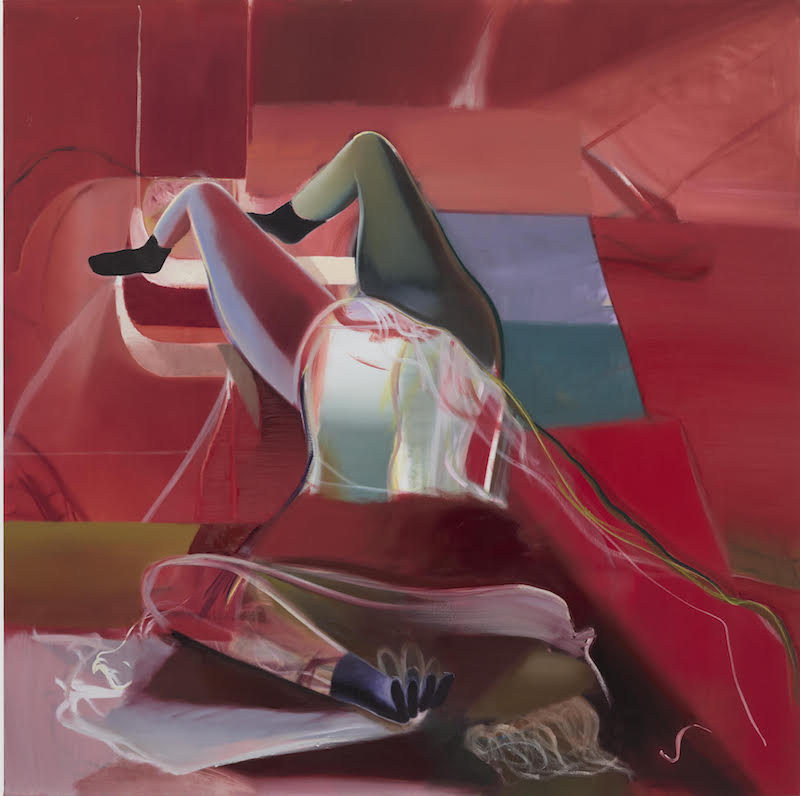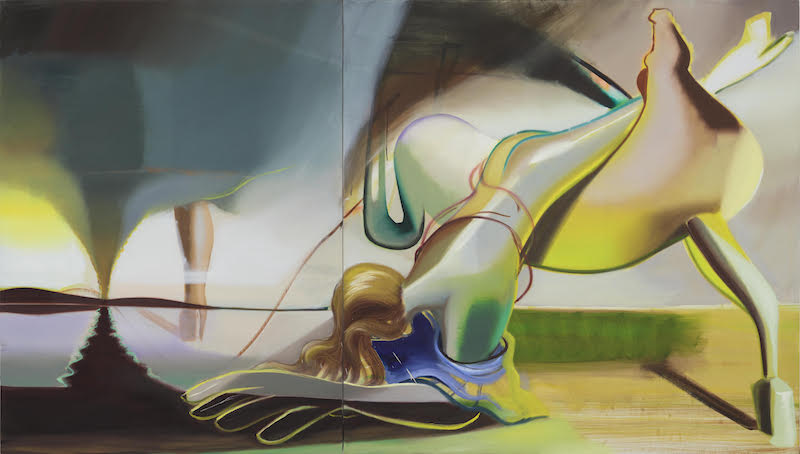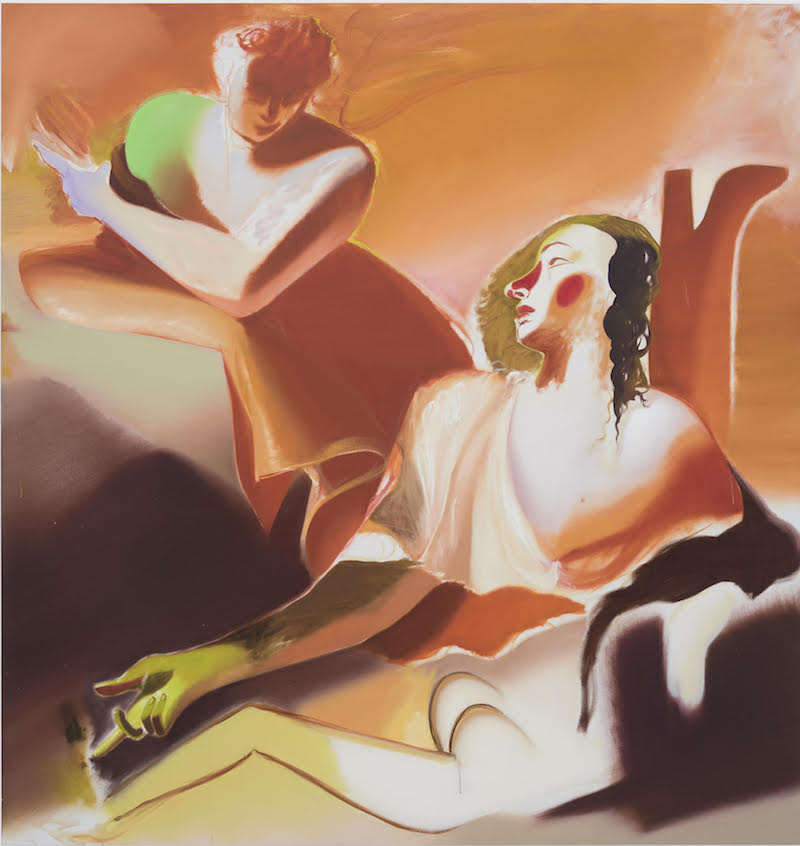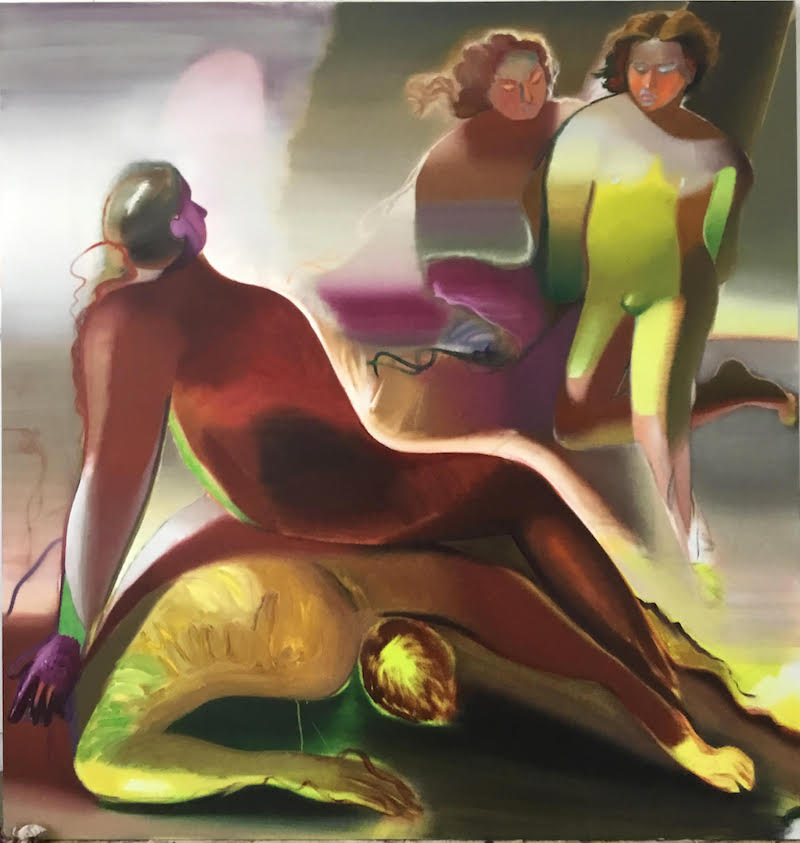Article by Elizabeth Schippers // May 15, 2020
This article is part of our artist Spotlight Series.
Katherina Olschbaur’s compositions melt human bodies, objects, formal elements and animals in a cluster of different parts, creating assemblages that suggest malleability and possibilities for change. Applying tactics derived from Surrealism, her expressive, gestural strokes are reflective of her approach to her subject matter. Olschbaur comes from Bregenz, Austria, and graduated from the University of Applied Arts in Vienna. She now lives and works between Vienna and Los Angeles.
In her practice, Olschbaur provides a female perspective on the patriarchal art historical canon from which she simultaneously pulls, as she explores the possibility for the subversion of these oppressive structures. Allyson Unzicker, Associate Director and Curator of the University Art Galleries at UC Irvine, curated Olschbaur’s recent exhibition ‘Dirty Elements’ at the gallery. In a publication accompanying the exhibition, Unzicker delineates Olschbaur’s investigation of patriarchal power dynamics and their systematic and violent denial of the female body and sexuality.

Katherina Olschbaur: ‘Sub Red,’ 2019, Oil on Linen, 200x200cm // Courtesy of the artist and Nicodim Gallery
In her essay ‘Petals in the Mud,’ Unzicker provides the reader with the context for Olschbaur’s practice. The artist draws on themes from mythology, as well as religious and historical artworks, which she transforms into sensual spaces and provocative scenes that examine concepts like devotion, submission, adoration and worship, and explore the possibility for a subversion of a patriarchal approach to power, gender and sexuality. ‘Sub Red’ (2019), for example, depicts a man nude, lying lifeless on the floor. The man’s crimson torso blends in with the red interior of the room, and his sickly-green head is merely suggested by a light brushstroke fading into the dark background. The soft blending and subtle transparencies are in stark contrast with the subject matter, as the painting, as Unzicker writes, “implies a scene of violent agitation.”
Unzicker explains that Olschbaur’s ‘Sub Red’ reflects on the art historical canon. She writes: “The posture in Sub Red emulates a photographic series by Martin Kippenberger, taken by his wife Elfie Semotan, in which the artist ironically mimics the poses of the subjects in Théodore Géricault’s The Raft of the Medusa (1819).” In one of the photographs, she explains, “Kippenberger imitates a headless corpse in the bottom right corner of the painting.” Draped over his bed, wearing only his socks and a watch, the artist’s lively body and prosaic setting play with the original drama and romanticism present in Géricault’s painting. With ‘Sub Red’ (2019), Olschbaur pulls this discourse in the direction of violence and sexuality, especially as it reflects the tensions within and between these themes.

Katherina Olschbaur: ‘Into the Open,’ 2019, Oil on Linen, Diptych, 200x350cm // Courtesy of the artist and Nicodim Gallery
‘Into the Open’ (2019) portrays a woman slanted on the ground, appearing to have fallen off her horse. She looks towards the distance, across the water, where one can see a tornado and a shoe, a high heel, rising up from behind the mountains. The woman’s arm is drawn with an abstraction that juxtaposes the mostly representative delineation of the female body. Olschbaur’s work is characterised by stark contrasts between subdued backgrounds and neon-like highlights, here most prominent on the bucking horse. Horses, Unzicker says, are a common motif in Olschbaur’s work, which “symbolize strength and power while also connoting unbridled passion and sexuality.” The horse in this particular painting exudes a strength and fierceness that seems to oppose the vulnerable position of the slanted woman.

Katherina Olschbaur: ‘Me, Him or the Angel,’ 2019, Oil on Linen, 210x200cm // Courtesy of the artist and Nicodim Gallery
The painting is built up with loose brushstrokes and, by working with a wet-on-wet process, Olschbaur creates a space of constant malleability on her canvas that results in dream-like landscapes, which disallow any singular perspective and instead promote a multiplicity of moving parts. This sense of disorder is central to her work, and Olschbaur highlights this tension by focussing on what Unzicker aptly describes as the representations of the body as “a site of repressed desire.” Figures are often depicted fallen, bound or in otherwise precarious positions, while simultaneously blending in with the other figures. With gestural and disruptive strokes, Olschbaur suggests room for abstraction outside of established structures. In her paintings, faces blur, limbs are represented as negative spaces and bodies merge with abstract shapes.
In this way, Olschbaur reflects on the tension between patriarchal power structures and erotic practices, while simultaneously creating a surreal landscape that, rather than being prescriptive, highlights the possibility for constant re-assemblage.
Artist Info

Katherina Olschbaur: ‘Vision, or How i became part of society,’ 2019, Oil on Linen, 210x200cm // Courtesy of the artist and Nicodim Gallery
Correction: In the first version of this article published on May 15, 2020, Allyson Unzicker’s essay on Katherina Olschbauer’s work was not cited properly. This revision was published on August 4, 2020.




















